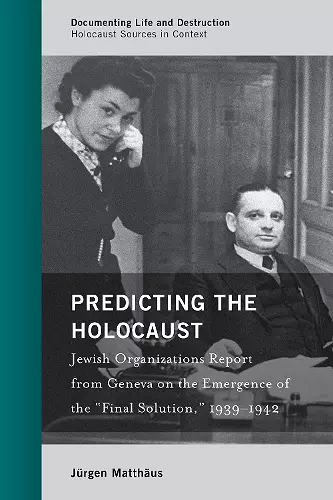Predicting the Holocaust
Jewish Organizations Report from Geneva on the Emergence of the “Final Solution,” 1939–1942
Format:Hardback
Publisher:Bloomsbury Publishing PLC
Published:14th Dec '18
Currently unavailable, and unfortunately no date known when it will be back

Published in association with the United States Holocaust Memorial Museum
Historians long have analyzed the emergence of the “final solution of the Jewish question” primarily on the basis of German documentation, devoting much less attention to wartime Jewish perceptions of the growing threat. Jürgen Matthäus fills this critical gap by showcasing the highly insightful reports compiled during the first half of World War II by two Geneva-based offices: those of Richard Lichtheim representing the Jewish Agency for Palestine and of Gerhart Riegner’s World Jewish Congress office. Since the first days of war, Lichtheim’s predictions of Jewish dead ran in the millions and increased progressively with the rising tide of Nazi rule over Europe. His and Riegner’s perceptions of German anti-Jewish policy resulted from shared goals and personal experiences as well as from their bureaus’ range of functions and the massive problems that impacted the gathering and communicating of information on the unfolding Holocaust in German-controlled Europe. Beyond the specifics of the wartime Geneva setting, these sources show how human cognition works in times of extreme crisis and contribute to a better understanding of the potential inherent in Jewish sources for gauging perpetrator actions. The reports and contextual information featured here reflect the first narratives on the Holocaust, their emergence, evolution, and importance for post-war historiography.
This latest analysis and collection of Jewish sources, focusing on prescient reports from Geneva, 1939--1942, is truly excellent. Despite decades of reading Holocaust documents, I found the accumulative effect of reading these reports powerful and moving. This volume is a superb addition to an important series. -- Christopher R. Browning
This volume provides invaluable insights and provokes important questions about the way a small group of uniquely positioned Jewish officials conceptualized Nazi anti-Jewish policy and its origins, logic, and trajectory at the time when the Holocaust was unfolding. The documents that form the centerpiece of the book are reports from 1939–1942 by Richard Lichtheim and Gerhart Riegner, the heads of the Geneva offices of two major Jewish organizations. These reports were shaped by a blend of personal experience (which in Lichtheim’s case included witnessing the Armenian genocide during the First World War), political perspectives, a location at a European diplomatic and lobbying hub, and the accompanying privileged yet partial access to factual information. Contrasting Riegner’s more famous claim to have revealed a particular ‘Hitler plan’ with Lichtheim’s earlier descriptions of a ‘vacillating’ German policy, the editor encourages us to reflect upon the way these narratives cohere with, and even informed, the cardinal competing scholarly interpretations of the development of the ‘final solution.’ -- Donald Bloxham, University of Edinburgh; author of The Final Solution: A Genocide
ISBN: 9781538121672
Dimensions: unknown
Weight: 503g
230 pages